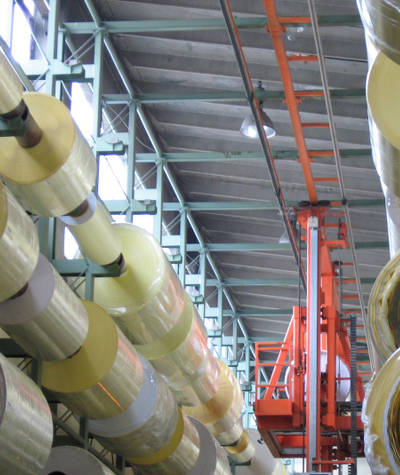ALIS PIK
ALIS PIK (Process Information Coordinator) is a MFCS (Material Flow Control System) subsystem providing a link between the parent ALIS GIK module and peripheral transport segments.
Transport routes usually consist of sequences of different process segments, such as:
- Automated trucks and carts.
- Roller and hanging chain conveyors.
- Vertical conveyors and lifting tables.
- Curved and straight rail-guided VNA lifts.
- Automated quality control and packaging systems.
PIK module's primary job is to synchronize and coordinate these segments, optimizing the flow of goods from entry to exit points. It operates based on the black box principle — it has all of the information needed to run the physical transport independently of other ALIS modules or external systems. To make this possible, material identification points are equiped with various types of additional peripherals, which PIK also operates:
- Sensors, scales and loading gauges.
- Barcode scanners and RFID receivers.
- Signs, lights, computer monitors and other status/information display devices.

Performance Optimization
Various complexities are to be expected at some warehouse facilities. Both one and two-way transport routes may exist, individual segments may overlap, or there can be more than one physical route from the entry to the exit point of a particular route.
PIK optimizes operations with real-time analysis of transportation requirements as well as the current status, availability and congestion of transport segments. It dynamically shifts tasks to alternative routes, based on predefined or operator assigned priorities.
High-Bay and VNA Warehouses
A special subset of internal logic is devoted to controlling automated VNA (Very Narrow Aisle) and/or High-Bay (10–40 meters and higher) warehouses with conventional (straight-rail) or curved-rail guided lifts. The additional functionality includes:
Performance and storage space optimization using special management algorithms based on independent view of storage location occupancy.
Combining inbound and outbound flows to execute sets of two-way transportation tasks.
Optimal coordination of multiple curved-rail guided lifts operating on the same tracks.
Strict recording of operating hours and all special events, such as equipment malfunctions or communication problems (to help with maintenance and planning).
Congestion resolving from a safe distance, with operators using service-mode commands to manually control transport segments.
Congestion Resolving
In case of a process segment failure, PIK will automatically check for alternative routes and redirect the affected flows, minimizing any interruptions to normal operations. This ensures maximum availability of the transport system.
We have also developed a separate user interface to be used when automatic resolution is not feasible. It contains special tools designed for simple and effective manual handling of such failures as well as other unexpected physical bottlenecks.
History and Users
ALIS PIK is a modern product designed for the new generation of communication hardware and software. Software in its present form was designed, developed and tested in the 2004–2016 period.
However, PIK is also based on, or heavily influenced by, the previous generations of similar process control systems, developed between 1988 and 1998 and running on DOS, OS-9 and OS/2 systems.
Some major facilities that use ALIS PIK:
- Aero d.d., Celje (materials and products warehouse).
- Krka d.d., Novo mesto (packaging materials warehouse).
- Lek d.d., Prevalje (raw materials warehouse).
- Merkur d.d., Ljubljana (consumer products warehouse).
- Steklarna Hrastnik d.d., Hrastnik (materials and products warehouse).

